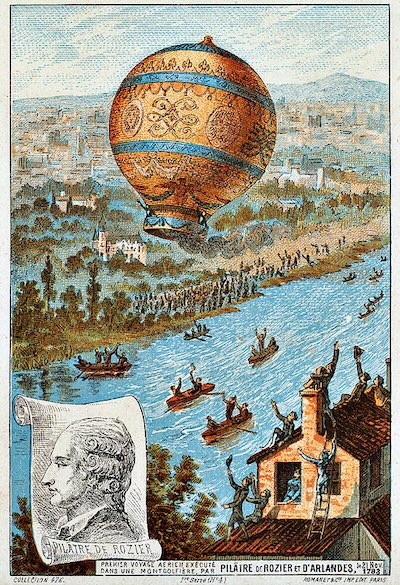Summary | Excerpt | Reviews | Beyond the Book | Read-Alikes | Genres & Themes | Author Bio

A Novel
by Marcy DermanskyThis article relates to Hot Air
The novel Hot Air begins with a hot air balloon falling from the sky into a backyard pool. Hot air balloons have a long history dating back to the eighteenth century, significantly predating the airplane. The hot air balloon was invented by French paper manufacturers (and brothers) Joseph Michel and Jacques-Etienne Montgolfier, who were inspired by watching the way hot air lifted a paper or fabric bag. The first manned, untethered hot air balloon flight was in 1783.
 Aboard were balloon pilot Jean Francois Pilatre de Rozier, who had earlier in the year carried out the first tethered manned flight, and nobleman Marquis Francois D'Arlandes. The passengers remained in the air for 25 minutes and travelled five miles. This first balloon was made of paper and silk, with a fire that was hand-fed by the occupants.
Aboard were balloon pilot Jean Francois Pilatre de Rozier, who had earlier in the year carried out the first tethered manned flight, and nobleman Marquis Francois D'Arlandes. The passengers remained in the air for 25 minutes and travelled five miles. This first balloon was made of paper and silk, with a fire that was hand-fed by the occupants.
Just 10 days later, physicist Jacques Alexander Charles launched the first gas-powered balloon. Unlike the hot air balloon, this aircraft was powered not by heat but by hydrogen, a gas that's lighter than air. This gas-powered type became the predominant form of flying balloon during the early days of air travel. Much later, 1960 saw the invention of the modern hot air balloon, which is powered by a propane gas burner.
Both historical and modern versions of the hot air balloon are based on the scientific principle that hot air has less mass per volume than cooler air and thus is able to rise. Hot air balloons have a burner positioned under the balloon opening, allowing the air to be reheated and the balloon to continue rising. There is an upper limit to how high they can go, as the air very high in the sky is so thin that the force of the hot air can no longer lift the balloon.
Balloon pilots can lift the balloon by moving a control that opens the burner's propane valve. As the flame increases in size, the balloon will rise faster. They can also pull a cord to open the balloon's parachute valve, which allows some hot air to escape. This can help slow the balloon's rise, or even lower it. Balloon pilots can't actually maneuver the vehicle from side to side directly. They can only move up and down in order to catch and ride with the wind. This means that no pilot has full control over where the balloon will fly. Therefore, they usually have a ground crew for support and aim to land in a wide-open space.
If you've got the balloon bug, you might want to check out a hot air balloon event. One of the most scenic is the annual hot air balloon festival that takes place every August in Cappadocia, Turkey. Scores of balloons take flight over a stunning desert landscape, giving the setting a magical feel. You can book a tour on one of the balloons, but even the photos captured from the ground at this event are jaw-dropping.
If competitive sports are more your thing, you can follow along with the World Hot Air Balloon Championship. Pilots are given specific tasks, like dropping a marker from their balloon onto a precise target, to test their ballooning skills.
As with other vehicles, operating a hot air balloon requires a valid license. In the U.S., these are granted by the FAA. You can actually get the first level of licensure, a Student Balloon Pilot Certificate, at just 14 years old! Getting a student license is simple, but it only allows you to pilot a balloon under the direct supervision of a private instructor. The next level, a Private Balloon Pilot Certificate, allows you to fly recreationally without supervision—but you'll need ten hours of flight training and a passing score on a knowledge test to qualify. To fly balloons professionally, you'll need to log more flight hours and pass further tests to get a Commercial Balloon Pilot Certificate—so don't go quitting your day job just yet.
It's heartening to know that there are strict requirements for becoming a hot air balloon pilot in the U.S. It makes backyard crash landings like the one in Hot Air a whole lot less likely!
One of a set of collectible cards with pictures of events in ballooning history, depicting the first aerial voyage with Pilâtre de Rozier and d'Arlandes on November 21, 1783, courtesy of Library of Congress
Filed under Cultural Curiosities
![]() This article relates to Hot Air.
It first ran in the April 23, 2025
issue of BookBrowse Recommends.
This article relates to Hot Air.
It first ran in the April 23, 2025
issue of BookBrowse Recommends.
A library, to modify the famous metaphor of Socrates, should be the delivery room for the birth of ideas--a place ...
Click Here to find out who said this, as well as discovering other famous literary quotes!
Your guide toexceptional books
BookBrowse seeks out and recommends the best in contemporary fiction and nonfiction—books that not only engage and entertain but also deepen our understanding of ourselves and the world around us.